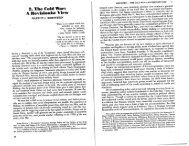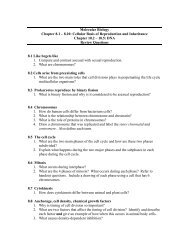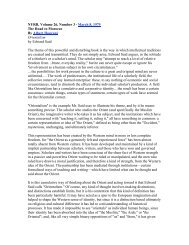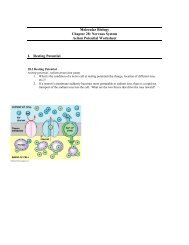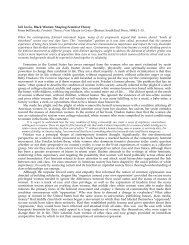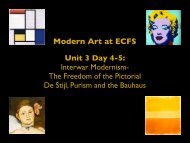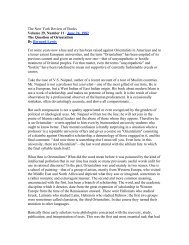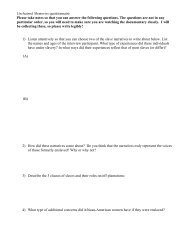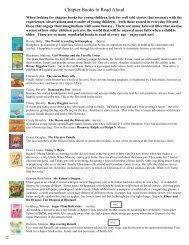fieldston american reader volume i â fall 2007 - Ethical Culture ...
fieldston american reader volume i â fall 2007 - Ethical Culture ...
fieldston american reader volume i â fall 2007 - Ethical Culture ...
- No tags were found...
Create successful ePaper yourself
Turn your PDF publications into a flip-book with our unique Google optimized e-Paper software.
Margaret Fuller:The Great Lawsuit (1810‐1850)Sarah Margaret Fuller was born at Cambridgeport (now partof Cambridge), Massachusetts, on May 23, 1810. Her fathersupervised her education, making her a prodigy but depriving herof a childhood. After a brief, traumatic stay at a girls’ school in herearly teens, she returned to pursue her rigorous education at home,steeping herself in the classics and in modern languages and literatures,especially German. Accustomed to intense, lonely study, Fullernevertheless formed lasting intellectual and emotional friendshipswith a few young Harvard scholars, among them her cobiographersJames Freeman Clarke and W. H. Channing. A Cambridge lady,Eliza Farrar, undertook to instill some of the social graces into thefather‐taught Margaret. The death of her father in 1835 burdenedFuller with the education of younger brothers and sisters. Settingaside her own ambitions (including a planned trip to Europe), shetaught for several years, in Boston and Providence. During thistime the German novelist and dramatist Goethe became the chiefinfluence on her religion and philosophy, and she tormented herselfwith the hope that she might have money, time, and ability to writehis biography. In 1839 she began leading “Conversation” classesamong an elite group of Boston women. Later, men participatedalso; and during the next years her topics included Greek mythology,the fine arts, ethics, education, demonology, creeds, and the ideal.A close friend of Emerson’s since she first sought him out in 1836,Fuller edited the Transcendentalists’ magazine The Dial from 1840to 1842, meanwhile continuing to translate works by and aboutGoethe. In 1844 Summer on the Lakes, an account of a trip to theMidwest, led Horace Greeley to hire her as literary critic for his NewYork Tribune, making her one of the first self‐supporting Americanwoman journalists. More than a literary reviewer, Fuller wrote aseries of reports on public questions, among them the conditions ofthe blind, of the insane, and of female prisoners. In 1845 Greeleypublished her Woman in the Nineteenth Century, the title articleof which was an expansion of a controversial Dial essay, The GreatLawsuit. This is one of the great neglected documents of Americansexual liberation—not merely of feminism, for Fuller recognized thatboth men and women were imprisoned by social roles, although menat least had the power to make and enforce the definitions of thoseroles. In 1846 some of her Tribune pieces were collected in Paperson Literature and Art. In New York she fell in love with JamesNathan, a German Jew who, a cosmopolite baffled by her mixtureof sexual honesty and prudery, fled home in June 1845, letting thegrowing spaces between his letters persuade her gradually that hehad rejected her.Fuller sailed for Europe in August 1846, intending to supportherself as foreign correspondent for the Tribune. In England one ofher idols, Thomas Carlyle (then in his fifties), disappointed her byhis reactionary political views and his insensitivity to the worthof others. especially the Italian revolutionary Joseph Mazzini, whohad sought refuge in England. In Paris she met another idol, GeorgeSand, who proved more satisfactory than Carlyle, and anotherpolitical revolutionary, the exiled Polish poet Adam Mickiewicz.Sand’s example of sexually liberated womanhood stirred Fullerprofoundly, as did Mickiewicz’s blunt speculation that she could notdeeply respond to Europe while remaining a virgin—not the sortof comment men like Emerson and Greeley had accustomed her to.Fuller went on to Italy, then not a unified country but a collection ofstates—some controlled by the pope, others independent, and to thenorth, a third group controlled by Austria. Soon after her arrival inRome she became the object of courtship by a Roman of the nobility,Giovanni Angelo Ossoli, almost eleven years younger than she.When she resumed from summering in northern Italy, Rome wasundergoing antipapal ferment, and her dispatches to the Tribunebecame more and more political. Making use of her connections withvarying factions, she began an earnest accumulation of documentsconcerning the forthcoming revolution—newspapers, pamphlets,leaflets.And she began a love affair with Ossoli. In December she waspregnant, with no man or woman she could confide in, either in theUnited States or Europe. At the start of 1848 she wrote guardedlyto a friend at home: “With this year I enter upon a sphere of mydestiny so difficult that at present I see no way out except throughthe gate of death.” Marriage seemed out of the question because of thecertain opposition of Ossoli’s family. Through a dismal rainy season,in which she lived on pennies a day, Fuller covered for the Tribunesuch events as the popular agitation against the Jesuits. She becameintimate with the Princess Belgioioso, a leader of the anti‐Austrianfaction who drew her still more deeply into Italian politics. Whencities of northern Italy revolted against the Austrians in March,Fuller described to her New York <strong>reader</strong>s the joyous response of theRoman citizens. The revolutionaries Mickiewicz and Mazzinientered Italy; both kept in touch with Fuller out of their respect forher personal commitment to their goals and their sense of her valuein shaping American opinion.That spring, 1848, Emerson wrote from England urging herto return home with him before war broke out. Still keeping hersecret, she withdrew instead to the Abruzzi region to wait out herpregnancy. Ossoli had become a member of the civic guard, buthe managed to be with her for the birth of Angelo on September5. Leaving the baby in Rieti with a wet nurse, Fuller returnedto Rome late in November, in time to report the flight of the popeand, early in 1849, the arrival of the Italian nationalist GiuseppeGaribaldi and the proclamation of the Roman Republic. She sharedthe triumph of Mazzini’s arrival in Rome, but the republic wasshort‐lived. Anticipating the intervention of the French on behalfof the pope, Princess Belgioioso urgently wrote Fuller on April30, 1849: “You are named Regolatrice of the Hospital of the FateBene Fratelli”—on an island in the Tiber. Fuller ran the hospitalheroically when the French laid siege, despite her concern for Ossoli,who was fighting with the Republican forces, and her uncertainty232 <strong>fieldston</strong> <strong>american</strong> <strong>reader</strong> <strong>volume</strong> i – <strong>fall</strong> <strong>2007</strong>



